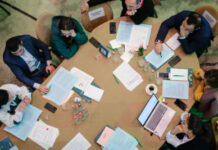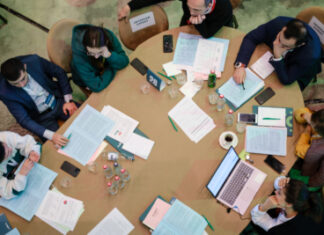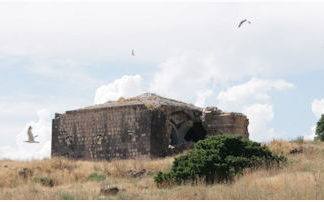NEW YORK — A memorial is planned for the late Jack Antreassian, a writer, editor, publisher and executive director of both the AGBU and the Eastern Diocese publ icat ions , who died on July 4, here, following an illness. He was 89. The memorial service will be held at St. Vartan Cathedral on Sunday, July 26, at 4 p.m.
Jack (Ardavast) Antreassian was born on April 20, 1920, in Constantinople, where his family had sought shelter from pogroms perpetrated in their native Hazari, Chimishgezeg. His father went ahead to New York City to prepare the way for the rest of the family (and to begin his new career as a barber).
Six months after their arrival in Istanbul, his mother, Satenig, brought Anne, Varsenig and baby Ardavast to New York. Three older brothers — Ardashes, Ashod and Antranig (who became an eloquent leader and writer in the Armenian-speaking world) — had to be placed in an orphanage in Greece, and could only join the others a few years later.
First settling on East 27th Street in New York’s “Little Armenia,” the Antreassians eventually moved to Washington Heights. Jack Antreassian won a scholarship to Stuyvesant High School, then went to City College for two years before leaving to help support the family, despite his father’s pleas for him to stay in school.
In 1943, on a furlough from his three-year stint in the Air Force, he married Alice Eksouzian, whom he had met through his sister Anne. He often related their love-at-firstsight story: “I remember her smile. I fell in love with her the minute I saw her and we knew from that first moment that there would be no one else.” The couple had two children, Michael and Elise, and enjoyed all the pleasures of young family life in the home they bought in Flushing, Queens, next door to his sister Varsenig and brother-in-law George.
Passionate about literature and poetry, Jack Antreassian continued to write even as he entered a long and distinguished career of public service in the Armenian community. He apprenticed at the Armenian Mirror- Spectator (to which he returned a few times later as editor) under the fatherly and cherished tutelage of Bedros Norehad. He later served as executive director of the AGBU at its East 40th Street headquarters in New York, where he launched an ambitious Armenian cultural program of art exhibits, concerts and classes. During his tenure, the local chapters nationwide were strong and numerous — dozens existed and were the main strength of the organization. He did a great deal of traveling in an effort to encourage and cultivate chapter growth. On a national level, he helped establish the Antranig Dance Group, Camp Nubar and the Araratquarterly, a literary magazine that featured Armenian artists and writers (with a sizable non-Armenian subscriber list — it was even sold at newsstands) which he edited for its first eight years. He later established Ararat Press, a brief publishing venture of fiction, drama and poetry.
Offered the executive position at the Diocese of the Armenian Church of America, Antreassian worked with the Primate, Archbishop Torkom Manoogian (now Patriarch of Jerusalem), for several years bringing the same creative leadership to the work of the Diocese. It was during this “Golden Age” of the Diocesan headquarters that a number of exciting programs were born: the Festival of the Armenian Spirit; the One World Festival, a huge cultural event co-sponsored with New York City that featured international dance groups and food and attracted thousands of visitors to the Cathedral and St. Vartan Park; Friday Night Open House — evenings of Armenian food, games and special programs; Pro Musica, scholarships and concerts for young Armenians in the performing arts and the St. Vartan Drama Group, among others.
These were the early days of the Diocesan Center, in the wake of the consecration of St. Vartan Cathedral. The center was alive with activity — with classes in art appreciation, language, cooking and history, exhibits and “talk show” interview evenings with notable Armenians — that a popular newsletter was released called Center News. He also launched St. Vartan Press, among whose titles was the enormously lucrative cookbook, Armenian Cooking Today, a labor of love written and donated by his wife Alice, which earned many thousands of dollars for the Diocese.
In leading both of these Armenian institutions, Antreassian set many precedents: introducing the Armenian public to important national and international personalities such as Aram Khachaturian, Rouben Mamoulian, Michael Arlen, William Saroyan and Ben Bagdikian among others (the special evenings featuring these talents were exciting community events); forming and serving on dozens of energetic committees; providing opportunities for writers, artists, and musicians to work and serve, launching many a career in the process.
Along with his strong, innovative leadership, Jack Antreassian possessed a rare quality for a community leader. In a tribute in the Mirror- Spectator to him and Bedros Norehad, two of the paper’s illustrious editors, Michael Zeytoonian noted that Antreassian “ had a wonderful and unassuming charisma…and possessed a keen ability to relate to all types of people, to meet them at whatever place they were at in their lives and to bring them into the fold. His sense of community and grasp of the notion that every individual has a role in the greater good were infectious.”
Upon retiring, Antreassian returned to the Diocese at the request of Archbishop Manoogian, to oversee the massive relief efforts for the 1988 earthquake in Armenia, traveling there himself a number of times. This effort was eventually to evolve into the highly effective Fund for Armenian Relief (FAR).
But perhaps his most important “second career” venture was Ashod Press, a publishing project named for his beloved brother who died in the Spanish Civil War. The effort, based on a highly personal vision of seeing Armenian literature translated and new writers encouraged and cultivated, produced 32 titles of great Armenian literature, original poetry, essays, memoirs and its own quarterly newsletter. In 1989, when a friend (who wished to remain anonymous) approached him with the idea of a literary prize for Armenian writers, Antreassian was instrumental in creating the annual “Anahid Award.” This has so far celebrated the achievement of 19 writers, granting each a $5,000 stipend and the recognition of a grateful community.
Antreassian was blessed with a large extended family for whom he felt great affection, counting them as yet another gift in his life. He is survived by his daughter Elise, her husband Papken who was like a son to him, and their children (and his adoring grandchildren) Kohar, Aris and Vahan Bayizian, with whom he lived for the past 15 years, as well as a son, Michael, his wife Brenda, and their son Adam.
He also leaves his wife Alice. When she developed Alzheimer’s 15 years ago, Antreassian devotedly cared for her first at home, then at his daughter’s house; when she finally had to enter the New York Armenian Home, where Antreassian visited her daily, sometimes twice a day.
During his own illness, to which he succumbed on Saturday, July 4, he was philosophical. “I have lived a long, happy life. I would be a fool to complain now that I have to leave it. What a lucky man I have been…”
Luckier were those who knew and loved him.
The family has asked that in-lieu-of-flowers donations go to the New York Armenian Home, in Flushing, NY.








